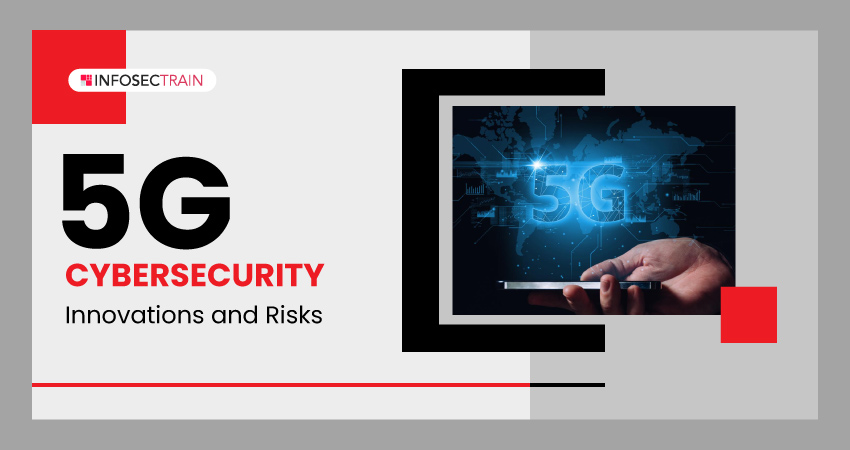5G Cybersecurity: Innovations and Risks
In the rapidly evolving telecommunications landscape, the emergence and widespread implementation of fifth-generation wireless technology, commonly known as 5G, has garnered significant attention due to its potential to revolutionize connectivity and drive transformative advancements across industries. This revolutionary advance lays the groundwork for cutting-edge technologies like autonomous vehicles, the Internet of Things (IoT), and augmented reality. It also promises exponential improvements in data transmission speeds, latency reduction, and network capacity. However, alongside these remarkable prospects, deploying 5G networks introduces a complex interplay of cybersecurity challenges and risks that necessitate comprehensive exploration and proactive mitigation strategies.

Table of Contents
What is 5G?
What is Cybersecurity?
5G Cyberseurity: Innovations
5G Cybersecurity: Risks
Navigating Cybersecurity Challenges in the 5G Era
What is 5G?
5G, or fifth-generation wireless technology, is the latest generation of mobile communication technology designed to provide faster data speeds, lower latency, increased capacity, and improved connectivity for various devices, including smartphones, Internet of Things (IoT) devices, and more. It represents a significant leap forward from its predecessor, 4G (LTE) technology.
What is Cybersecurity?
The practice of defending networks, computers, software, and digital data from various cyber threats and attacks is known as cybersecurity. Its primary goal is to ensure the confidentiality, integrity, and availability of digital assets and information. Cybersecurity uses various tactics, procedures, and tools to protect digital assets from dangers such as malware, phishing, hacking, unauthorized access, and data breaches.
5G Cyberseurity: Innovations
5G’s inherent characteristics, including improved latency, bandwidth, and interoperability, align with its overarching goal of providing seamless connectivity and supporting many applications. The technology’s advancements are poised to revolutionize various industries, such as the Internet of Things (IoT), cloud computing, and artificial intelligence (AI), while contributing significantly to economic growth. The mobile device industry, responsible for approximately 4.5% of the global gross domestic product (GDP), stands to benefit immensely from 5G’s deployment, supported by its projected 20 billion IoT connections and staggering data generation of 45 exabytes per month by 2025. Here are the advantages and innovations of 5G.
- Enhanced Latency, Bandwidth, and Interoperability: 5G technology brings about significantly improved latency (minimal delays), higher bandwidth (faster data transmission), and enhanced interoperability (seamless communication between devices). These attributes collectively aim to provide a more fluid and responsive digital experience.
- Enabling Seamless Connectivity and Versatile Applications: With its fundamental attributes, 5G is poised to provide uninterrupted connectivity and support a diverse range of applications. From real-time communication to data-intensive applications like augmented reality and IoT devices, 5G’s capabilities lay the foundation for a new era of innovation.
5G Cybersecurity: Risks
The increased speed and complexity of 5G also introduce new security challenges. Here are some of the key 5G cybersecurity risks:
- The Emergence of Software-Defined Networking (SDN): 5G introduces new paradigms like Software-Defined Networking (SDN), altering how networks are managed and orchestrated. While SDN offers benefits, it also presents new avenues for cyber threats due to its complexity.
- Vulnerabilities Introduced by Network Function Virtualization (NFV): Network Function Virtualization (NFV) further complicates the landscape by virtualizing network services. While enhancing flexibility, this shift introduces potential vulnerabilities that malicious actors could exploit.
- Amplified Risk of Denial-of-Service (DoS) Attacks: The proliferation of 5G devices and increased accessibility heighten the risk of Denial-of-Service (DoS) attacks, which can disrupt services by overwhelming networks with traffic.
- Escalating Concerns about Eavesdropping and Spoofing: As 5G expands, so do concerns regarding eavesdropping and spoofing, where cybercriminals intercept communications or deceive devices into accepting malicious data.
Navigating Cybersecurity Challenges in the 5G Era
1. Frameworks for Comprehensive Security
- Leverage established frameworks like ISO, NIST, and CIS for robust cybersecurity.
- Define security policies, procedures, and controls tailored to 5G’s unique characteristics.
- Create a solid foundation to address evolving threats.
2. Strengthening Auditors’ Proficiency
- Demand for specialized skills in networking and telecommunication is rising.
- Equip auditors with technical expertise to assess intricate 5G network security.
3. Proactive Threat Detection and Prevention
- 5G’s extensible architecture requires proactive threat detection.
- Intrusion detection and prevention systems play a pivotal role.
- Implement machine learning and big data analytics to identify anomalies.
- Domain Name System (DNS) intelligence enhances defense against attacks.
4. Prioritizing Risk Management
- Identify critical assets, assess vulnerabilities, and quantify potential impacts.
- Allocate resources strategically to protect valuable assets.
- Regular risk assessments adapt security strategies to emerging threats.
5. Balancing Innovation and Security
- Integrate security considerations into 5G network design.
- Balance innovation with robust security measures.
- Proactively identify and address vulnerabilities to prevent breaches.
Conclusion
The advancement of 5G necessitates a holistic approach that capitalizes on its innovations and effectively navigates its cybersecurity challenges. By embracing established frameworks, enhancing the skills of auditors, and prioritizing security measures, practitioners can ensure that the promises of 5G are realized while upholding the integrity, privacy, and reliability of the networks that underpin this technological evolution.
Navigating the complexities of 5G cybersecurity requires expertise and guidance. This is where InfosecTrain steps in as your trusted partner. InfosecTrain offers specialized courses tailored to empower professionals with the essential knowledge and skills to secure 5G networks effectively.
Our courses provide you with the tools to stay ahead of cyber threats in today’s fast-changing digital landscape. If you’re new to cybersecurity, our “Cyber Security Orientation Program (Foundation Level)” is an ideal starting point for beginners in the field.






 1800-843-7890 (India)
1800-843-7890 (India)